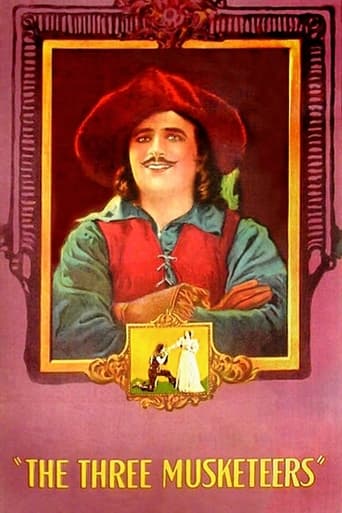MartinHafer
I think how much you'll enjoy the film will be impacted on how closely you want the film to follow the book (which it doesn't) as well as whether or not you've seen many of Douglas Fairbanks' films. What I mean by the latter is that I think my expectations were way too high for this movie because I expected a VERY physical and athletic film--but it wasn't. This was a HUGE surprise because Fairbanks was known for his amazing stunts--such as in "Thief of Bagdad" or "The Mark of Zorro". I expected to see his great leaps and bounds--but there just weren't very many athletic scenes. Now this is NOT to say that it's a bad film--it's still pretty good. It's just that I think it could have been a lot better. Enjoyable but not among the actor's best films--though the costumes and sets were pretty amazing for 1921.By the way, the version I saw was the one in the public domain that is linked to IMDb. Oddly, this version has reversed the last two reels of the film!! In other words, it ends and then continues! I am not sure if you can find a corrected version or not.
barbb1953
This is the best Fairbanks costume drama I've seen in terms of his agility, the dialogue, quality of action scenes and acting, and set. He just seemed to have it all together with this one, with his character's physical qualities impressing the King and a surprisingly deft battle of wits with Cardinal Richielieu impressing that dangerous man. It is said Fairbanks was a huge fan of Dumas, and indeed he showed deep enough acquaintance with the original "Three Musketeers" to successfully keep the original feel of the book (particularly the last section) while neatly cleaning it to be acceptable to 1920s morals (the Twenties may have roared, but they weren't yet ready for the Executioner of Lille; the darker side of Milady and Athos; Constance's infidelity and tragic end; the anti-Puritan stereotyping; D'Artagnan's becoming not just the talk of Paris but that city's most popular and busy lover of high-society ladies, including just about everybody but the Queen), and so forth.The original three musketeers did much to keep all that subplot going, and this may be why Fairbanks gives them relatively little to do in the movie. Too, he seems to be focusing on the latter part of the book where D'Artagnan does come to the fore, though if anything, he toned down D'Artagnan's role, too (if you haven't read the book, you're in an over-the-top tour de force, believe me!).Anyway, the physical performances by Fairbanks that stand out here include, of course, the famous left-handed handspring during the duel (in which we learn what happens when the bad guy, not Indiana Jones, brings a gun to a sword fight); the horsemanship Doug displays; the skill shown in the fencing scenes (he had come a long way from "Mark Of Zorro," which was not bad either); and the general agility he shows whether he's leaping into a cupboard or through a window or tiptoeing across the tip of a rooftop with a damsel in distress on his shoulder. Two sword-fights that stand out, besides the duel, are the one in the apothecary's shop, where not a single jar or bottle is broken in spite of the general mayhem going on between D'Artagnan and the Cardinal's best swordsman, and the scene where Fairbanks squares off against Milady (is this the only scene where Douglas Fairbanks fought a woman?).
JohnHowardReid
As with "The Prisoner of Zenda", the more colorful female role here is actually the second lead—in this case the wicked but exciting Milady de Winter, beautifully played by the exotic Barbara La Marr. This is not to say that the main feminine role (enacted by Marguerite De La Motte), does not have its share of excitement. Miss De La Motte shares some wonderful scenes not only with Fairbanks but with Mary MacLaren and Nigel de Brulier (whose study of the ruthless Richelieu is so compelling, he was hired to repeat his impersonation in three more swashbucklers).Fairbanks, of course, is suitably dashing as D'Artagnan, and his swordplay is certainly impressive throughout an action-full two hours. As producer he has made sure to bring his hero into conflict with many worthy opponents, including de Brulier's cardinal, Boyd Irwin's black count, Lon Poff's gray eminence, and even Adolphe Menjou's weak but self-important Louis.Three players who do receive short shrift, however, even though they share much footage with our hero, are Palette, Siegmann and Bary, who play the titular musketeers. Here they are so inadequately characterized, they make virtually no impression as individuals at all.However, if I have to choose between character development and swift pacing, I'll take swift pacing any day!
Craig Smith
Douglas Fairbanks knew how to be in the middle of the action. In all the scenes he is in it is go, go, go. He never walks when he can run, jump, even fly. Fairbanks was very athletic and he shows those skills in the movie. Very rarely in this film does he stand still and that is not for long. When he is in a scene there is always going to be plenty of action.The basic plot is that Fairbanks wants to become one of the King's musketeers and in the process finds himself involved in protecting the Queen's honor. The movie is a bit overlong and I found myself having troubles at time following the plot which made the move drag somewhat. But when there was action everything changed. The film comes alive during the scenes involving sword play and when Fairbanks is trying to get back to the Queen from England. And when all is said and done Fairbanks gets his wish and becomes (as you know he will) a Musketeer!


